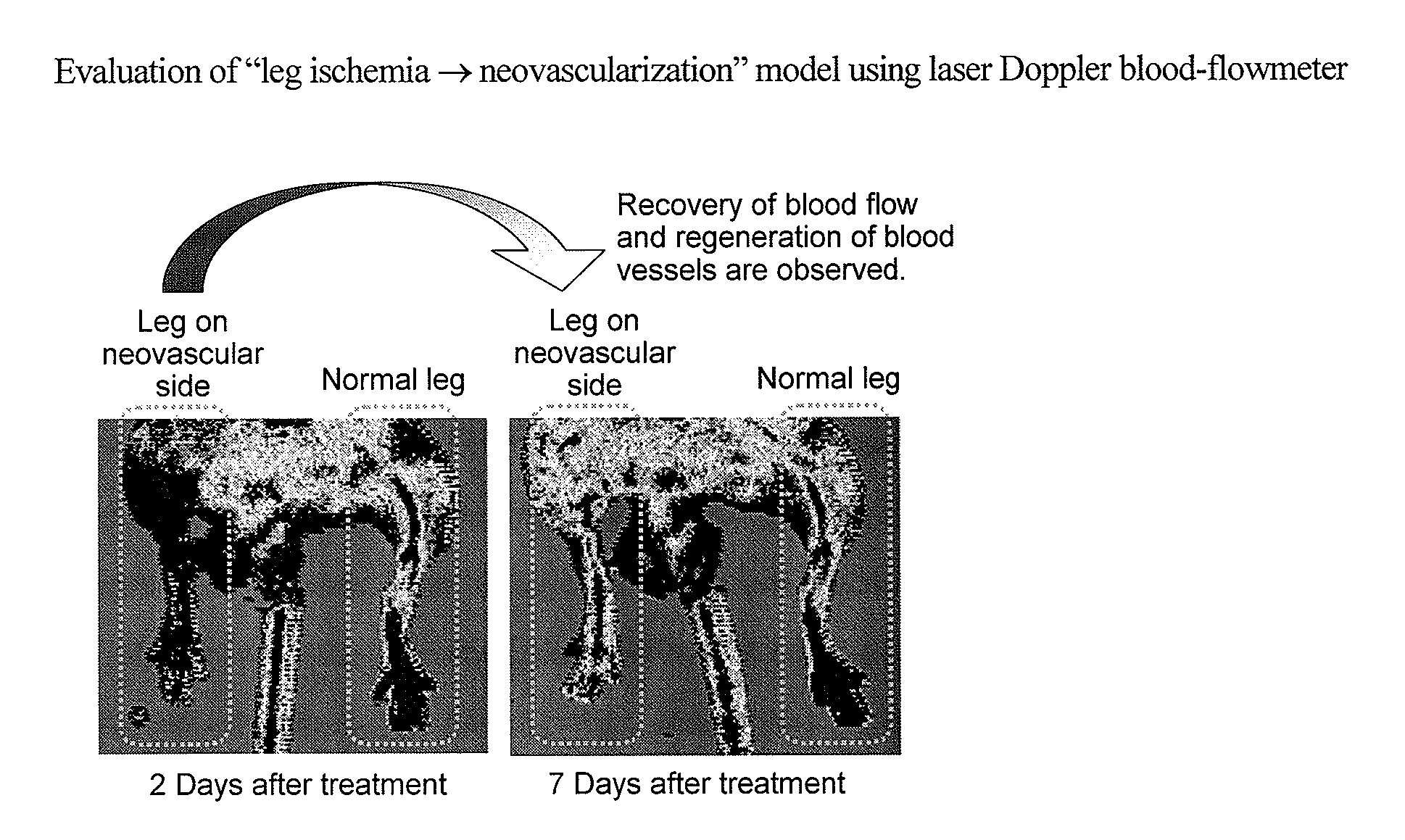Targeting agent to newly formed blood vessels
a blood vessel and target agent technology, applied in the direction of cardiovascular disorder, sense disorder, drug composition, etc., can solve the problems of insufficient tumor specificity, difficult for fdg to carry out tumor diagnosis in some cases, and difficult to make a diagnosis, so as to achieve short stay in a neovascular site
Active Publication Date: 2012-06-21
FUJIFILM CORP +1
View PDF5 Cites 9 Cited by
- Summary
- Abstract
- Description
- Claims
- Application Information
AI Technical Summary
Benefits of technology
[0040]The targeting agent to a neovascular site of the present invention enables the drug delivery to a neovascular site and the imaging of such a neovascular site, utilizing the effect of the agent to accumulate in the neovascular site. Moreover, the targeting agent to a neovascular site of the present invention is characterized in that it has a blood retention property higher than that of a commonly studied circular RGD compound and in that its stay in a neovascular site is short.
Problems solved by technology
However, such FDG only targets to a cell and / or tissue site having high glucose-metabolizing activity, and thus its tumor specificity is not sufficient.
Since FDG highly accumulates even in the brain, heart, liver and the like as a result of physiological accumulation, it is problematic in that it may be difficult for FDG to carry out tumor diagnosis in some cases.
In addition, in the urinary system such as the kidney, ureter or bladder, background increases as a result of a large amount of FDG discharged into urine, and thus it is difficult to make a diagnosis.
However, an imaging agent has various problems such as lack of specificity to newly formed blood vessels or lack of persistency, and consequently, sufficient results have not yet been obtained.
However, since the aforementioned circular RGD compound is rapidly discharged from the body mainly by renal excretion after it has been administered, its retention time in the body is short.
Accordingly, when this compound is used as a targeting agent such as a drug delivery agent or an imaging agent, it is problematic in that a time in which its targeting ability can be utilized is short, and in that a majority of the compound is discharged from the body before it reaches a target site.
Thus, the circular RGD peptide has been problematic in that it takes a long period of time until a signal disappears from a neovascular site in some cases.
However, it has not been known that such biopolymers can be used for the imaging of newly formed blood vessels.
Method used
the structure of the environmentally friendly knitted fabric provided by the present invention; figure 2 Flow chart of the yarn wrapping machine for environmentally friendly knitted fabrics and storage devices; image 3 Is the parameter map of the yarn covering machine
View moreImage
Smart Image Click on the blue labels to locate them in the text.
Smart ImageViewing Examples
Examples
Experimental program
Comparison scheme
Effect test
examples
[0097]As a recombinant gelatin, CBE3 (WO2008-103041) described below was prepared.
the structure of the environmentally friendly knitted fabric provided by the present invention; figure 2 Flow chart of the yarn wrapping machine for environmentally friendly knitted fabrics and storage devices; image 3 Is the parameter map of the yarn covering machine
Login to View More PUM
| Property | Measurement | Unit |
|---|---|---|
| Force | aaaaa | aaaaa |
| Electric charge | aaaaa | aaaaa |
| Electric potential / voltage | aaaaa | aaaaa |
Login to View More
Abstract
It is an object of the present invention to provide a targeting agent that enables drug delivery to a neovascular site and the imaging of such a neovascular site, utilizing the effect of the agent to accumulate in the neovascular site. The present invention provides a targeting agent to a neovascular site, which comprises a gelatin-like protein.
Description
TECHNICAL FIELD[0001]The present invention relates to a targeting agent to newly formed blood vessels that uses a gelatin-like protein.BACKGROUND ART[0002]The term “angiogenesis” mainly refers to a phenomenon in which newly formed blood vessels are formed from existing blood vessels. Examples of normal and physiological angiogenesis include angiogenesis in fetal life and angiogenesis involved in formation of the endometrium / corpus luteum, wound healing, or the like. On the other hand, it has been known that pathologic angiogenesis is deeply associated with the growth or metastasis of a solid tumor, chronic inflammation such as diabetic retinopathy or rheumatoid arthritis, and the like. In particular, tumoral angiogenesis has been vigorously studied from both sides of treatment and diagnosis. It has been considered that a tumor having a diameter of 1 to 2 mm can obtain oxygen or nutrient as a result of diffusion from existing blood vessels. However, for a further growth, angiogenesis...
Claims
the structure of the environmentally friendly knitted fabric provided by the present invention; figure 2 Flow chart of the yarn wrapping machine for environmentally friendly knitted fabrics and storage devices; image 3 Is the parameter map of the yarn covering machine
Login to View More Application Information
Patent Timeline
 Login to View More
Login to View More IPC IPC(8): A61K51/08A61K49/00A61P9/00A61K49/04A61K47/42A61K38/39A61K49/14
CPCA61K47/48238A61K49/0002A61K38/39C07K14/78A61K51/082A61K51/088A61K47/62A61P9/00A61P9/10A61P27/16A61P35/00A61P43/00
Inventor NAKAMURA, KENTAROTABATA, YASUHIKO
Owner FUJIFILM CORP
Features
- R&D
- Intellectual Property
- Life Sciences
- Materials
- Tech Scout
Why Patsnap Eureka
- Unparalleled Data Quality
- Higher Quality Content
- 60% Fewer Hallucinations
Social media
Patsnap Eureka Blog
Learn More Browse by: Latest US Patents, China's latest patents, Technical Efficacy Thesaurus, Application Domain, Technology Topic, Popular Technical Reports.
© 2025 PatSnap. All rights reserved.Legal|Privacy policy|Modern Slavery Act Transparency Statement|Sitemap|About US| Contact US: help@patsnap.com



